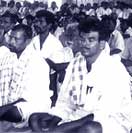| |
A NEW BEGINNING |
|
| Forging
ties
|
||
| WATER LITERACY | ||
| Informing
people Water play The facilitator Water Gala |
||
| IN FOCUS | ||
| Faulty
perceptions Thirst rises, patience evaporates |
||
| URBAN WETLANDS | ||
| Eviction
ordered Join the BIG fight Citizens pick up cudgels Solar lakes |
||
| WATER MANAGEMENT | ||
| South
India: Searching for an identity Thailand: Then came progress.... |
||
INITIATIVE |
||
| An eye
opener Naudihi’s revival Tankas of Badi Ghodan Dialogue |
||
CSE'S LATEST DESIGNS |
||
| Sri
Aurobindo Ashram’s system |
||
TECHNOLOGY |
||
| Rice
husk ash filter Clay pot irrigation |
||
| JAL YODHAS | ||
| Sachidanand
Bharti Madhu Bhatnagar |
||
TRADITION |
||
| Naullahs
of Kumaon |
||
WATER IN NEWS |
||
| Kerala,
building up its jalanidhi Schemes or scams? |
||
GREEN WATER HARVESTER'S NEWS |
||
| Saving
lives Rain associations Review |
||
CLASSROOM |
||
| Drop by
drop Water scramble |
||
FUNDING AGENCY |
||
| Oxfam
and water |
||
| 100
promises, deadline 2006 The landmarks Changing currents |
||

Vol.
5
No. 2
April-May 2003
The age old community-based water management systems are on the crossroads. The present-day governments and aid agencies in their bid to ‘modernise’ these systems have in fact ruined them. Weathering this downward slide, these traditions still continue to hold a place of prominence. For instance, in Nepal and in the Philippines, about three-quarters and half of the irrigated land, respectively is still being managed by the traditional water managers. Will these systems survive or peter out in history?
| The facilitators |
Jal bhajan This 60 minute audio has ten inspirational songs on traditional water systems of India. These compositions highlight the tradition, culture, significance of rain in our lives. ‘Yah hi vo dharti’, is one of the beautiful song — unfolding the pivotal role played by water in every aspect of human life. The wise use |
S O U T H I N D I A
Searching for an identity
About 1,000 neerkattis from Tamil Nadu, Andhra Pradesh and Karnataka got an opportunity to voice their concerns during a seminar held by Dhan Foundation (DF), a Madurai-based NGO, on March 10, 2003.
The tradition and its decayMost of the neerkattis belong to lower castes and are appointed by the village community on a hereditary or an annual rotational basis. The number of neerkattis managing a tank varies from one to as many as 12 persons. It depends on the size of the tank and the supply channels. As remuneration, they receive one marakka ie five kg of grain per acre or equivalent cash. Before 1950s, their main responsibilities were: distribution of water on a rotational basis; managing sluice gates; and, maintenance works. As the responsiblity of managing tanks has been passed on to the Public Works Department (PWD), the role of neerkatti is now been reduced to just opening and closing of sluices. Instead of maintaining the tank during non-monsoon season, they generally assist the village administrative officer in the departmental work. As farmers’ switched to well irrigation, tanks became insignificant.
The changing social structure at the village level has intensified this trend. The ownership of land has shifted from the upper to the lower castes. According to a study conducted by Sivasubramanian from Madras Institute of Development Studies, "Between 1850 and 1912 the land holding pattern of Kaveripakkam area, Chennai, changed completely". It is significant to note that the tank of this area is one of the biggest in Tamil Nadu - once irrigating more than 14 villages is in a degraded state, today.
 The voices
The voices
The Madurai convention gave neerkattis a platform to share their concerns and redefine
their roles. In general, the participants felt that they were not adequately paid. Veeran,
who has been working as a neerkatti for the past 12 years, from Kambur village, Madurai,
said, "The village tank irrigates 60 acres of paddy. However, the remuneration fixed
is kuzhikku naalu padi ie 6.5 kg per 60 cents (100 cents = 1 acre). Even this meager
amount is not regularly paid." Another neerkatti from Thiruvarangai village,
Ramanathapuram, Solomon felt that "The work involves more risk and is less assured as
the tanks do not get regularly filled - just once in 3 or 5 years." Ganesan from
Madaivini Patti, Madurai, who was facilitated by the former president K R Narayanan for
his services as a neerkatti, share these concerns. "I get a very small amount. None
of my five sons wants to become a neerkatti. I am doing it as a service to the community
and god." Not many think like Ganesan. Why should they? Most of the neerkattis are
experts in tank management - they are at par with any well-experienced irrigation
engineer. R Sakthivadivel from International Water Management Institute, Sri Lanka,
suggests, "The government should effectively include neerkattis in water users
associations of tank renovation programs. It will save state crores of rupees while
returning control back to where it actually belongs." Neerkattis are at the
crossroad. Their survival depends on whether the state and society are ready to treat the
issue from a fresh perspective or not.